
Hibiscus is a genus of flowering plants in the mallow family, Malvaceae. The genus is quite large, comprising several hundred species that are native to warm temperate, subtropical and tropical regions throughout the world. Member species are renowned for their large, showy flowers and those species are commonly known simply as "hibiscus", or less widely known as rose mallow. Other names include hardy hibiscus, rose of sharon, and tropical hibiscus.
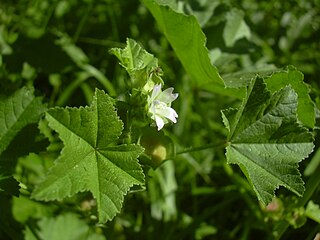
Malvaceae, or the mallows, is a family of flowering plants estimated to contain 244 genera with 4225 known species. Well-known members of economic importance include okra, cotton, cacao and durian. There are also some genera containing familiar ornamentals, such as Alcea (hollyhock), Malva (mallow), and Tilia. The largest genera in terms of number of species include Hibiscus, Sterculia, Dombeya, Pavonia and Sida.

Abutilon is a large genus of flowering plants in the mallow family, Malvaceae. It is distributed throughout the tropics and subtropics of the Americas, Africa, Asia, and Australia. General common names include Indian mallow and velvetleaf; ornamental varieties may be known as room maple, parlor maple, or flowering maple. The genus name is an 18th-century New Latin word that came from the Arabic ’abū-ṭīlūn, the name given by Avicenna to this or a similar genus.
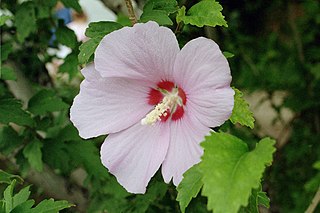
Hibiscus syriacus is a species of flowering plant in the mallow family, Malvaceae. It is native to Korea, and south-central and southeast China, but widely introduced elsewhere, including much of Asia. It was given the epithet syriacus because it had been collected from gardens in Syria. Common names include the rose of Sharon,, Syrian ketmia, shrub althea, and rose mallow. It is the national flower of South Korea and is mentioned in the South Korean national anthem.

Hibiscus rosa-sinensis, known colloquially as Chinese hibiscus, China rose, Hawaiian hibiscus, rose mallow and shoeblack plant, is a species of tropical hibiscus, a flowering plant in the Hibisceae tribe of the family Malvaceae. It is widely cultivated as an ornamental plant in the tropics and subtropics, but its native range is Vanuatu.

Hibiscus tiliaceus, commonly known as the sea hibiscus or coast cottonwood, is a species of flowering tree in the mallow family, Malvaceae, with a pantropical distribution along coastlines. It has also been introduced to Florida and New Zealand. It has been debated whether this species is native or introduced to Hawaii.

Hibiscus laevis, the halberd-leaf rosemallow, is a herbaceous perennial flower native to central and eastern North America. Their showy, creamy-white or pink flowers are large, up to 15 centimetres (6 in) across, and are hard to miss. These flowers require exposure to sunlight to open up properly, and then last only a single day.

Abelmoschus is a genus of about fifteen species of flowering plants in the mallow family (Malvaceae), native to tropical Africa, Asia and northern Australia. It was formerly included within Hibiscus, but is now classified as a distinct genus. The genus name derives from Arabic meaning 'father of musk' or 'source of musk' referring to the scented seeds.

Malva moschata, the musk mallow or musk-mallow, is a species of flowering plant in the family Malvaceae, native to Europe and southwestern Asia, from Spain north to the British Isles and Poland, and east to southern Russia and Turkey. Growing to 60 cm (24 in) tall, it is a herbaceous perennial with hairy stems and foliage, and pink saucer-shaped flowers in summer.

Hibiscus acetosella, the cranberry hibiscus or African rosemallow, is a flowering plant of the family Malvaceae. The epithet acetosella is of Latin origin and is a diminutive of the Latin name for sorrel which comes from the sour taste experienced when eating the young leaves of both plants. Hibiscus acetosella is also known colloquially as false roselle, maroon mallow, red leaved hibiscus, and red shield hibiscus. It is one of the approximately 200–300 species that are seen in sub-tropic and tropic regions. This ornamental is usually found in abandoned fields or open areas, marshes, and forest clearings. Cranberry hibiscus is a member of a perennial group known as hardy hibiscus. In contrast to the tropical hibiscus, hardy hibiscus can tolerate colder conditions, are more vigorous, longer lasting, and have larger flowers. In colder climates, Hibiscus acetosella is easily an annual, but is often regarded as a perennial to zone 8–11. During one season, the plant can grow 90–170 cm (3.0–5.6 ft) tall and 75 cm (30 in) wide as a shrub-subshrub.

Hibiscus moscheutos, the rose mallow, swamp rose-mallow, crimsoneyed rosemallow, or eastern rosemallow, is a species of flowering plant in the family Malvaceae. It is a cold-hardy perennial wetland plant that can grow in large colonies. The hirsute leaves are of variable morphology, but are commonly deltoidal in shape with up to three lobes. It is found in wetlands and along the riverine systems of the eastern United States from Texas to the Atlantic states, its territory extending northward to southern Ontario.
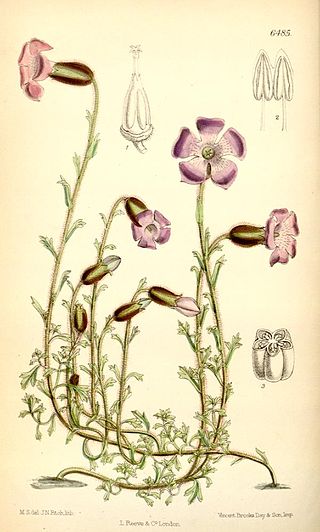
Cyananthus lobatus, commonly known as the lobed-leaved cyananth or trailing bellflower, is an ornamental flowering plant of the family Campanulaceae.

Hibiscus coccineus, the scarlet rosemallow, is a hardy Hibiscus species that looks much like Cannabis sativa (marijuana). It is also known as Texas star, brilliant hibiscus, and scarlet hibiscus.

Iliamna is a small genus of flowering plants in the mallow family, endemic to North America. It is related to the bush mallows of California (Malacothamnus) and to Phymosia of Mexico, Central America and the Caribbean. These perennial herbs are known commonly as wild hollyhocks and sometimes as globe mallows, Kankakee mallow, Kankakee globe mallow, and Streambank wild hollyhock. More often, the latter terms refer to members of the genus Sphaeralcea, which belong, like Iliamna, to the "typical" mallow tribe (Malveae) of the mallow and hibiscus subfamily Malvoideae. The name of the genus, proposed by Edward Lee Greene, appears to be a reference to Iliamna Lake in Alaska, even though the genus Iliamna does not occur in Alaska

Hibiscus denudatus is a perennial shrub of the mallow family, Malvaceae. It is in the rosemallow genus, Hibiscus.

Hibiscus splendens, the splendid hibiscus, is a species of flowering shrub or tree in the mallow family, Malvaceae. Other common names include hollyhock tree and pink cottonwood. H. splendens is a fairly common plant native to eastern Australia. The range of natural distribution is from Wollongong in the state of New South Wales to Blackdown Tableland National Park in central east Queensland. The habitat is on clearings or disturbances around the margins of the drier rainforests.
Hibiscus cravenii is a species of flowering plant in the mallow family, Malvaceae, that is endemic to the Northern Territory in Australia.
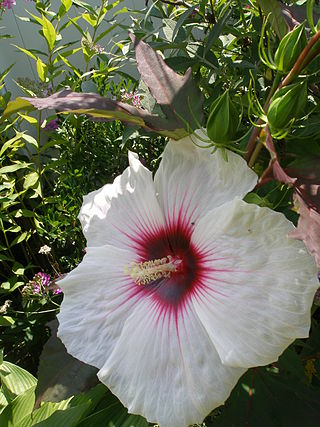
Hibiscus 'Kopper King' is a cultivar of Hibiscus that has large, showy flowers and copper-colored lobed leaves. It was bred and selected for its aesthetic attributes as well as its cold hardiness to at least −30 °F (−34 °C) by Jim, Bob, and Dave Fleming of Fleming's Flower Fields in Lincoln, Nebraska. 'Kopper King' is a compact perennial shrub, reaching 3–4 ft (0.9–1.2 m) tall with a 2–4 ft (0.6–1.2 m) spread. The leaves are coppery red to dark purple, with a lobed and toothed leaf shape that appears to be similar to some maples. New growth will emerge in late May or early June and the plant will bloom from midsummer to early fall at the first frost. Each flower, with its cream to light-pink petals and deep red eye in the center streaking outward toward the margin, is borne singly from the leaf axils and can be 8–12 in (20.3–30.5 cm) in diameter. Each flower only lasts one day but new blooms are typically produced in succession, allowing for almost continuous flowering. The flower display is flat with petals overlapping. Overall, the plant is resistant to pests and diseases, although it can be severely damaged by Japanese beetles.
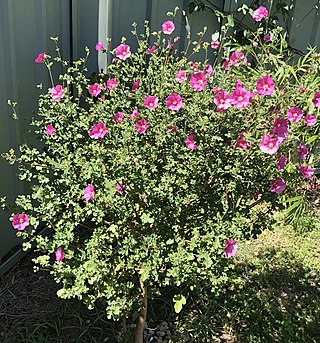
Anisodontea capensis, known as African mallow, dwarf hibiscus, Cape mallow and false mallow, is a species in the tribe Malveae in the family Malvaceae that is native to South Africa. It has gained the Royal Horticultural Society's Award of Garden Merit as an ornamental.

Hibiscus vitifolius, the grape-leaved mallow or tropical rose mallow, is a species of flowering plant in the family Malvaceae. It is native to the seasonally dry Old World tropics and subtropics, and has been introduced to most of the islands of the Caribbean. A perennial herb reaching 2 m (6 ft) and becoming woody at maturity, it is found in a wide variety of habitats, and is a weed of cultivation. It is used locally as a source of fiber, often mixed with jute.




















